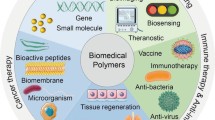Abstract
We synthesized B-He/B-GREDVY and immobilized them on avidin-coated surfaces. To examine the immobilization of molecules in the material, the following experiments were performed: fluorescein isothiocyanate (FITC) fluorescence staining, water contact angle and atomic force microscopy (AFM) measurements. Besides, the biological evaluation experiments were also performed, such as platelets adhesion and activation, the culturing of smooth muscle cells (SMC) and endothelial cells (EC). These experimental results show that the modified surfaces could prevent the hyperproliferation of SMC, and promote the proliferation and migration of EC and EPC. Furthermore, the adding of VEGF improved the EC adhesion in a dynamic environment. Generally, it is expected that the modified surfaces could be used to accelerate the formation of the newly endothelial layer for the construction of platforms for coronary artery stent therapy.
Similar content being viewed by others
References
Macovei L, Magopet R, Tanasa A, et al. Coronary Artery Bypass Graf Surgery Versus Percutaneous Coronary Intervention in Unprotected Left Main Coronary Artery Disease: A Systematic Review[J]. Reviews in Cardiovascular Medicine, 2020, 21: 65–73
Urbanczyk M, Layland S L and Schenke-Layland K. The Role of Extracellular Matrix in Biomechanics and Its Impact on Bioengineering of Cells and 3D Tissues[J]. Matrix Biology, 2020, 85–86: 1–14
Cidonio G, Glinka M, Kim Y H, et al. Nanoclay-Based 3D Printed Scaffolds Promote Vascular Ingrowth Ex- Vivo and Generate Bone Mineral Tissue in Vitro and in Vivo[J]. Biofabrication, 2020, 12: 035 010
Daum R, Visser D, Wild C, et al. Fibronectin Adsorption on Electrospun Synthetic Vascular Grafts Attracts Endothelial Progenitor Cells and Promotes Endothelialization in Dynamic in Vitro Culture[J]. Cells, 2020, 9: 778
Guo X, Wang X, Li X, et al. Endothelial Cell Migration on Poly(epsilon-caprolactone) Nanofibers Coated with a Nanohybrid Shish-Kebab Structure Mimicking Collagen Fibrils[J]. Biomacromolecules, 2020, 21: 1 202–1 213
Luong J H T, Male K B and Glennon J D. Biotin Interference in Immunoassays Based on Biotin-Strept(Avidin) Chemistry: An Emerging Threat[J]. Biotechnology Advances, 2019, 37: 634–641
Yang Y, Gao P, Wang J, et al. Endothelium-Mimicking Multifunctional Coating Modified Cardiovascular Stents via a Stepwise Metal-Catechol-(Amine) Surface Engineering Strategy[J]. Research (Wash D C), 2020, 2020: 1–20
Katsuki T, Tomoi Y, Yamaji K, et al. Combination Therapy of Heparin-Bonded Covered Stent and Bare-Nitinol Stent Assessed by Intravascular Ultrasound[J]. Heart Vessels, 2020, 35: 1 502–1 509
Ohya Y, Nishimura K, Sumida H, et al. Cellular Attachment Behavior on Biodegradable Polymer Surface Immobilizing Endothelial Cell-Specific Peptide[J]. Journal of Biomaterials Science Polymer Edition, 2020, 31: 1 475–1 488
Yang L, Huang X, Deng L, et al. Pre-Mounted Dry TAVI Valve With Improved Endothelialization Potential Using REDV-Loaded PEGMA Hydrogel Hybrid Pericardium[J]. Journal of Materials Chemistry. B, 2020, 8: 2 689–2 701
Butruk-Raszeja BA, Kuzminska A, Ciach T, et al. Endothelial Cell Growth on Polyurethane Modified with Acrylic Acid and REDV Peptide[J]. Surface Innovations, 2020, 8: 89–104
Wu Y, Yu C, Xing M, et al. Surface Modification of Polyvinyl Alcohol (PVA)/Polyacrylamide (PAAm) Hydrogels with Polydopamine and REDV for Improved Applicability[J]. Journal of Biomedical Materials Research. Part B, Applied Biomaterials, 2020, 108: 117–127
Liu S, Liu T, Chen J, et al. Influence of a Layer-by-Layer-Assembled Multilayer of Anti-CD34 Antibody, Vascular Endothelial Growth Factor, and Heparin on the Endothelialization and Anticoagulation of Titanium Surface[J]. Journal of Biomedical Materials Research. Part A, 2013, 101: 1 144–1 157
Tan J, Cui Y, Zeng Z, et al. Heparin/Poly-l-Lysine Nanoplatform with Growth Factor Delivery for Surface Modification of Cardiovascular Stents: The Influence of Vascular Endothelial Growth Factor Loading[J]. Journal of Biomedical Materials Research. Part A, 2020, 108: 1 295–1 304
Liu T, Zeng Z, Liu Y, et al. Surface Modification with Dopamine and Heparin/Poly-L-Lysine Nanoparticles Provides a Favorable Release Behavior for the Healing of Vascular Stent Lesions[J]. ACS Applied Materials & Interfaces, 2014, 6: 8 729–8 743
Zhang K, Liu T, Li J A, et al. Surface Modification of Implanted Cardiovascular Metal Stents: From Antithrombosis and Antirestenosis to Endothelialization[J]. Journal of Biomedical Materials Research. Part A 2014; 102: 588–609
Mahara A, Kojima K, Hirano Y, et al. Arg-Glu-Asp-Val Peptide Immobilized on an Acellular Graft Surface Inhibits Platelet Adhesion and Fibrin Clot Deposition in a Peptide Density-Dependent Manner[J]. ACS Biomaterials Science & Engineering, 2020, 6: 2 050–2 061
Chen X, Gu H, Lyu Z, et al. Sulfonate Groups and Saccharides as Essential Structural Elements in Heparin-Mimicking Polymers Used as Surface Modifiers: Optimization of Relative Contents for Antithrombogenic Properties[J]. ACS Applied Materials & Interfaces., 2018, 10: 1 440–1 449
Plouffe B D, Njoka D N, Harris J, et al. Peptide-Mediated Selective Adhesion of Smooth Muscle and Endothelial Cells in Microfluidic Shear Flow[J]. Langmuir, 2007, 23: 5 050–5 055
Seeto W J, Tian Y and Lipke E A. Peptide-Grafted Poly(Ethylene Glycol) Hydrogels Support Dynamic Adhesion of Endothelial Progenitor Cells[J]. Acta Biomaterialia, 2013, 9: 8 279–8 289
Parisi L, Toffoli A, Ghezzi B, et al. A Glance on the Role of Fibronectin in Controlling Cell Response at Biomaterial Interface[J]. The Japanese Dental Science Review, 2020, 56: 50–55
Author information
Authors and Affiliations
Corresponding author
Ethics declarations
All authors declare that there are no competing interests.
Additional information
Funded by the National Natural Science Foundation of China (Nos.32271377 and 31870955) and the National Key Research and Development of China (No.2020YFC1107300-03)
Rights and permissions
About this article
Cite this article
Wei, L., Tan, J., Li, L. et al. Effect of VEGF/GREDVY Modified Surface on Vascular Cells Behavior. J. Wuhan Univ. Technol.-Mat. Sci. Edit. 39, 244–254 (2024). https://doi.org/10.1007/s11595-024-2877-7
Received:
Accepted:
Published:
Issue Date:
DOI: https://doi.org/10.1007/s11595-024-2877-7




